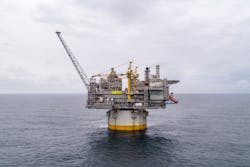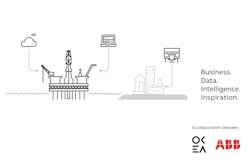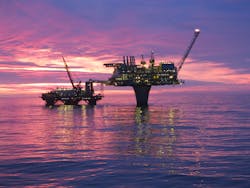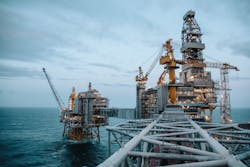Digital technologies leading industry toward autonomous operations
Drivers include cost reduction, safety, sustainability
Martin Grady, ABB Energy Industries
Autonomous operations can help make systems safer, more capable and reliable, as well as more cost-effective. Removing people from the process reduces the scope for errors and improves safety. The journey toward autonomous operations is happening in the energy sector, predominantly now where digital technologies are being used to sense, measure, and control connected assets.
Drivers for autonomous operations
Drivers for autonomous operations are multi-faceted and can change from operator to operator depending on the exact asset or process to be automated.
There are several trends that are driving exploration and production within the energy sector, with the most notable being the rise of digitalization and the need for companies to ensure their facilities are safer and more efficient.
The strongest driver, that can be seen from several directions in the industry, is cost reduction. Since the oil price plummeted in 2014, reducing the capital and operating costs has been a key priority for energy companies. There has always been a focus on safety and the prospect of removing people from the hazards of offshore operations has been a tantalizing prospect for the oil and gas market. Then of course we are increasingly starting to evaluate how we can make operations more sustainable by reducing carbon intensity and improving efficiency. The desire to look at whether there are alternatives to the way things are done currently, with a more sustainable outcome. It is a challenge that the energy industry is actively addressing and will continue to address.
However, it is not a journey the industry can jump into; it is a steady progression rather than a revolution. Commonly it is seen as a five-step process starting with isolated operations that includes connectivity to shore automation and some on-board automation, moving through connected operations where on-platform sensors and servers are added, then integrated operations, remote operations, and finally achieving autonomous operations.
An operator must ensure proper measures and competence are in place before moving from one level of autonomy to the next. In a highly regulated industry, input and collective decision making from technology providers like ABB, operators, and regulators is necessary to help the energy sector progress through the steps.
Reducing costs
A milestone on the journey toward autonomous operations came last year at the Aasta Hansteen platform. Located in 1,300 m (4,265 ft) of water in the Norwegian Sea and 300 km (186 mi) from land, automation was used to improve start up time and reduce capex costs.
Digital solutions driven by the need to reduce costly schedule delays, served as the basis Aasta Hansteen’s fully automated first gas start-up process. To achieve this, a sequence of more than 1,000 manual interventions needed to be reduced to as few as possible. The outcome is a series of buttons that are as simple as starting a car.
The teams went through the start-up steps, identified and defined obstacles that needed to be improved, then used the ABB Ability System 800xA simulator to do a virtual start-up of the plant. It was at this stage that a lot of improvements were made for starting up and operating the plant. Through automating much of the process the company managed to reduce a complex set of manual interventions to just 20. It is estimated that this process saved about 40 days in the commissioning phase of the project.
Safety first with predictive maintenance
One of the most significant trends is the drive toward unmanned and autonomous operations of offshore platforms. This increase in the ability of platforms to run themselves, and to move the engineers who monitor them to onshore control rooms has resulted from cost reduction pressures, safety, and increasing environmental concerns. Supplying an offshore crew and flying them back and forth by helicopter is an expensive and inherently dangerous business. Ever more capable automation systems hold out the prospect of running a production facility either with no, or very low, staffing levels – like an old-fashioned lighthouse.
One of the primary reasons for a physical presence in offshore and remote facilities is maintenance intervention. For offshore operators, reducing persons on-board by one can justify an investment of about $1 million.¹ Reducing the number of human operators also enhances plant safety by lowering the risk of on-site accidents, whatever the cause.
Therefore, refining and reducing maintenance operations is vitally important and a necessary part of operators’ journey toward autonomy.
Traditional maintenance routines are based on service time, not actual requirements, despite the fact 70 to 90% of failures are unrelated to equipment age. The problem with such approaches is that considerable effort is devoted to devices that are working perfectly well. It also does not address the reality where 20% of the equipment tends to cause 80% of the issues. Furthermore, up to 40% of production losses can be attributed to preventable operator errors where, in a typical facility, this could account for 1 to 2% of facility’s total production capacity. The result of excessive maintenance can be that facilities become less reliable due to increased human intervention.
Companies that use predictive maintenance, however, are alerted to issues that need addressing based on actual need. Failure modes are remotely monitored using sensors and dedicated analyses are performed to assess the equipment itself and/or its environment for clues to drive maintenance programs. When data is collected from a large amount of identical equipment operating under similar conditions, it becomes possible to build a precise model of that device’s degradation process. By reducing downtime for maintenance operations through a predictive approach, companies can optimize operations and avoid losses.
In practice, ABB engineers have been helping Australian natural gas company QCG, now owned by Shell, whose upstream facilities stretch across the Surat basin, where coal-seam gas is gathered and transported along a 540-km (336-mi) underground pipeline, to an LNG plant on Curtis Island near Gladstone.
All process facilities including control, safety, telecommunications, CCTV, electrical and maintenance systems are controlled and monitored via the ABB Ability System 800xA distributed control system allowing QCG total visibility of all assets and production. Live data gathered from its onshore unmanned operations, incorporating 24 field compression stations, six central processing plants, two water treatment plants, and two-training LNG export facilities are collated and reviewed at a central Collaborative Operations Centre, where advanced analytics on the health and performance of equipment, systems, and devices using the data can be assessed.
Taking the smart approach
For autonomous operations to be successful, open access and the ability to process and analyze huge volumes of data remotely in real time is critical. The company’s advances in this area continued this year in partnership with Norwegian oil and gas producer OKEA. They are using digitalization and automation to achieve substantial productivity gains through agile and dynamic business models.
Connectivity and the right infrastructure need to be in place as companies work toward increasingly autonomous operations. In the case of the Draugen platform, high-quality data is streamed to shore, creating a digital twin in real time. Unlike conventional digital twins of such systems, the data stream is transmitted right from the heart of the platform’s control system, without any sort of filtering or intermediate storage in databases. This ensures that the context is retained, allowing the users to recognize the data. The new streaming solution is called “Software-as-a-service” (SaaS), a widespread licensing and delivery model.
Making operations more sustainable
Although not commonly spoken about in the road to autonomous operations, the role of electrification and the advent of subsea operations is a key step on the way. Power is a big part of the subsea story. There have recently been significant developments in subsea technology that support the drive for autonomous operations which has often been called a ‘race to the bottom.’
Understandably questions are growing about the level of CO2 emissions from oil and gas upstream operations. Generating power with a gas turbine, or diesel generator on the platform is less efficient than power generated onshore which could be from the renewable source.
The company is delivering power-from-shore to the Johan Sverdrup field more than 200 km (124 mi) from the onshore grid on the Norwegian west coast. The four platforms that make up the first phase of the development are entirely powered from shore by the HVDC link supplied by ABB. In addition to the environmental benefits of powering the cluster of platforms from shore, the cable solution is safer and more energy-efficient than generating the power offshore using fossil fuels.
With a lot of scenarios, the developments in autonomous operation and advances in subsea technology go hand in hand. The effect is to remove equipment from the platform, and to do it in a way that needs less maintenance. Putting all of this on the seabed, by definition, means it must be autonomous.
In late 2019, the company reached a key milestone in proving its subsea power technology. By powering pumps and compressors on the seabed, closer to the reservoir, ABB’s subsea power distribution and conversion technology can reduce power consumption. There is potential for substantial energy savings, with reduced carbon emissions using power-from-shore. The company’s subsea power technology can connect to any power source, enabling future integrations with renewable energy, such as wind and hydro power. Moving the entire oil and gas production facility to the seabed is no longer a dream. Remotely operated, increasingly autonomous, subsea facilities powered by lower carbon energy are more likely to become a reality as we transition toward a new energy future.
The path ahead
Part of the story with autonomous activities is that with a very simple operation it is quite easy to make it autonomous. The challenge is to get that same degree of autonomy, on the complex, high hazard remote facilities in the offshore industry.
To a large extent the technology is there, but the industry is only deploying a fraction of the technology that it could. There are several barriers, perceived and real, that reflect operators’ appetite to embark on the five-step cycle fully. Not least is convincing themselves, that their systems are robust enough to get to the final stage.
It is a simple fact that if you do not set out to run something autonomously then it probably will not materialize. There must be a clear intent to move to autonomous operations from the outset. This is evidenced by a host of normally unmanned facilities in onshore operations and in the more benign environment of shallow water.
Inevitably the decision-making processes involve balancing the cost and benefits against the drivers and the pressures that the operator faces at any time. It also depends on the circumstances in terms of the expected life of the asset and the reserves.
There are layers of autonomy and benefits in the early stages and you need to go through these early stages to get more advanced. But that is where everyone must start. You are embarking on a journey that asks, how can we improve this operation? How can we reduce manning levels? What is it that we need the operators to do and that process of analysis? This will guide you through the five levels and show you how far you need to go at each facility.
To date plant operation technology has reached a level of autonomy somewhere between levels 2 and 3. Other technologies will soon follow suit. Robotics, for example, is also taking its first steps in the industry. Advanced robotics exist that are made specifically for the inspection of equipment. These robots can replace the manual inspection of facilities, including inside tanks and pipes, as well as other parts of the platform.
ABB works with its customers to provide digital solutions to assist them on the journey toward autonomous operations. From automated processes for plant start-up, through to simulators, remote operations, predictive maintenance and robotic inspection, the company can run data for analytics and enable autonomous engineering, operation and control for local optimizations and/or fleet management.
Reference
1. ABB White Paper: Next level oil, gas and chemicals. Harnessing the power of digitalization to thrive in the ‘new normal’ of low oil prices https://new.abb.com/images/librariesprovider94/whitepaper/digital-oil-gas-and-chemicals.png?sfvrsn=93c3bd12_0
The author
Martin Grady is Vice President and Global Industry Manager, Oil and Gas for ABB Energy Industries. He joined ICI plc in 1984 and held several engineering, production and senior management roles. He moved to ABB in 2001 as part of the acquisition of ICI’s engineering subsidiary, Eutech. Since then, he has held various senior management roles, including general manager of ABB’s Oil, Gas and Petrochemical business in the UK from 2011, which included responsibility for the Caspian region and major projects in Australia. From 2016 until his current appointment, he was a regional manager for ABB’s Oil, Gas and Chemicals business across nine countries. Martin holds a BSc degree in mechanical engineering from the University of Nottingham, UK. He is based in Billingham, UK. •



